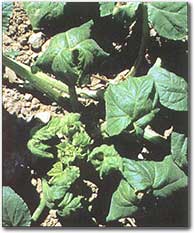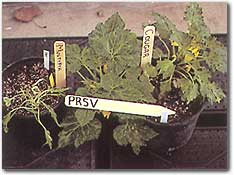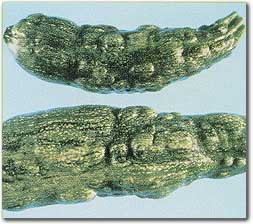|
September 2004
Introduction
Your squash crop faces many obstacles: weather, pests, disease.
Among the diseases affecting squash, powdery mildew and viruses
can be very destructive and difficult to control.
For years, chemical control of vectors was the primary means of
limiting loss to viral diseases like ZYMV. Chemicals still play
a major role today in disease control, though they are very
costly.
To protect profits, growers turn to squash varieties with
disease tolerance built-in, not added on.
Disease tolerance means less reliance on expensive chemicals. It
also means disease control from the start for a healthier, more
profitable crop.
Aphids - the ultimate vector
Aphids damage cucurbits in three ways:
- by direct feeding,
- by contamination with
excrements, and
- as vectors of viruses.
Aphids insert needle-sized sylets
through the skin to feed on phloem in the underlying tissue.
Infection is immediate - a few seconds of probing is all that's
needed to acquire the virus. This vector-aphid relationship is
called non-persistent and is characteristic of ZYMV, WMV-2, PRSV
and CMV.
The aphid's probing results in damage from the removal of
photosynthate needed to fill developing fruits. Aphids also feed
on the lower surfaces of the leaf, causing a downward cupping of
the leaf. This cupping forms a protected area in which aphids
can continue to feed and reproduce because insecticides can't
penetrate the cupping areas. Three aphid species colonize
cucurbits and can cause damage:
-
 the
melon aphid, Aphis gossypii, the
melon aphid, Aphis gossypii,
- the green peach aphid,
Myzys persicae, and
- the cowpea aphid,
Aphis craccivora.
Cucumber mosaic virus
One of our most destructive.
CMV exists everywhere squash is cultivated, but it is more
prevalent in the temperate regions of the world.
Symptoms: severe plant stunting, prominent foliar yellow mosaic,
malformation, and drastic reduction in leaf size and stem
internodes. Flowers may have prominent abnormalities and
greenish petals. Infected fruits become distorted and often
discolored, and usually remain small.
Control: traditional controls include insecticides, reflective
mulches, and mineral oils. Eradication of weed hosts is nearly
impossible because of the extensive host range of this virus.
Powdery mildew
 Powdery mildew reduces yield by decreasing
the number of fruit or the length of time crops can be harvested. The
primary pathogens that cause powdery mildew include Sphaerotheca
fuliginea and Erysiphe cichoracearum. Powdery mildew reduces yield by decreasing
the number of fruit or the length of time crops can be harvested. The
primary pathogens that cause powdery mildew include Sphaerotheca
fuliginea and Erysiphe cichoracearum.
Symptoms: whitish,
talcum-like powdery fungal growth develops on both leaf surfaces,
petioles and stems. Symptoms usually occur first on older leaves, on
shaded lower leaves, and on abaxial leaf surface. Older, fruit-bearing
plants are affected first. Infected leaves usually wither and die, and
plants senesce prematurely.
Control:
disease tolerant cultivars along with
fungicides are usually used to manage powdery mildew. Management with
fungicides requires the product reach the underside of the leaves and
the lower canopy. Systemic materials accomplish this. But strains of
powdery mildew are becoming more tolerant to these chemicals.
Resistance in fields and greenhouses has been detected in the US,
Europe and the Middle East. Disease tolerant
squash varieties offer the best protection.
 Papaya ringspot
virus Papaya ringspot
virus
Papaya ringspot virus
is common in tropical and subtropical areas. It occasionally causes
epidemics in some temperate regions.
Symptoms:
severe plant stunting. Foliage exhibits green mosaic, malformation,
puckering, blisters, distortion, and narrow laminae. Apical leaves are
frequently narrowed and are reduced to the main veins. Fruits are
malformed, such as knobby overgrowth accompanied by color break. It is
often found in association with WMV,
ZYMV and CMV.
Control: application of
insecticides for the control of aphid vectors of PRSV can limit the
spread of the virus.
 Watermelon
mosaic virus Watermelon
mosaic virus
First discovered in squash.
Watermelon mosaic virus is common in temperate regions as well as in
the tropics. It has been reported in most countries where cucurbits
are grown.
Symptoms:
foliar symptoms include green mosaic, leaf rugosity, green
vein banding, chlorotic rings, and malformation. Fruits are distorted
and green spots can occur, especially on yellow fruit.
Control: in addition to
mineral oil sprays to interfere with the virus transmissions and
insecticides to control aphid populations,
resistant cultivars can effectively control WMV.
 Zucchini yellow
mosaic virus Zucchini yellow
mosaic virus
Devastation in 22 countries on 5 continents.
Originally discovered in France and Italy,
ZYMV has caused epidemics worldwide.
Symptoms:
yellow mosaic, severe malformation. blisters, extreme reduction in the
size of leaf lamina, necrosis, and severe plant stunting. Squash also
develop knobby, malformed areas that develop deep longitudinal and
radial cracks. Control:
like all other aphid-transmitted viruses, ZYMV is extremely difficult
to control with insecticides, reflective mulches, and mineral oils.
Better results can be obtained with disease tolerant varieties like
Harris Moran's new varieties. |